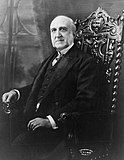| |||||||||||||||||||||||
Majority vote of each house needed to win | |||||||||||||||||||||||
|---|---|---|---|---|---|---|---|---|---|---|---|---|---|---|---|---|---|---|---|---|---|---|---|
| |||||||||||||||||||||||
| |||||||||||||||||||||||
The 1899 United States Senate election in New York was held on January 17, 1899. Incumbent Democratic Senator Edward Murphy Jr. stood for re-election to a second term but was defeated by Republican Chauncey Depew. Republicans had maintained control of both houses of the legislature in the 1898 New York state election.


